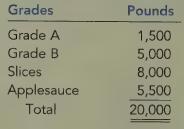Appletime, Inc., purchases apples from local orchards and sorts them into four categories. Grade A are large
Question:
Appletime, Inc., purchases apples from local orchards and sorts them into four categories.
Grade A are large blemish-free apples that can be sold to gourmet fruit sellers. Grade B apples are smaller and may be slightly out of proportion. These are packed in boxes and sold to grocery stores. Apples for slices are even smaller than Grade B apples and have blemishes. Apples for applesauce are of lower grade than apples for slices, yet still suitable for canning. Information on a recent purchase of 20,000 pounds of apples is as follows:
Total joint cost is $6,000.
Required:
1. Allocate the joint cost to the four grades of apples using the physical units method.
(Carry out the percent calculations to four significant digits.)
2. Allocate the joint cost to the four grades of apples by finding the average joint cost per pound and multiplying it by the number of pounds in the grade. (Round all cost allocations to the nearest dollar.)
3. What if there were 2,000 pounds of Grade A apples and 4,500 pounds of Grade B?
How would that affect the allocation of cost to these two grades? How would it affect the allocation of cost to the remaining common grades?LO1
Step by Step Answer:

Introduction To Cost Accounting
ISBN: 9780538749633
1st International Edition
Authors: Don R. Hansen, Maryanne Mowen, Liming Guan, Mowen/Hansen





